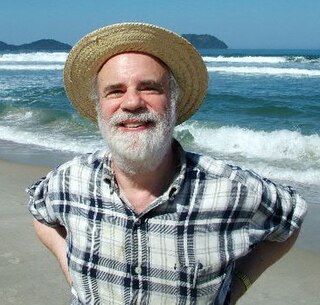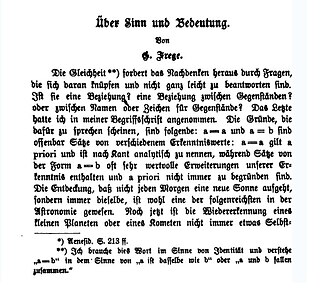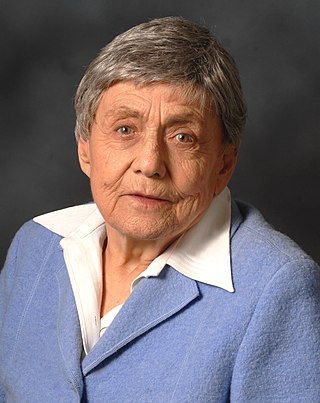
Saul Aaron Kripke was an American analytic philosopher and logician. He was Distinguished Professor of Philosophy at the Graduate Center of the City University of New York and emeritus professor at Princeton University. Kripke is considered one of the most important philosophers of the latter half of the 20th century. Since the 1960s, he has been a central figure in a number of fields related to mathematical and modal logic, philosophy of language and mathematics, metaphysics, epistemology, and recursion theory.

In the philosophy of language, the distinction between sense and reference was an idea of the German philosopher and mathematician Gottlob Frege in 1892, reflecting the two ways he believed a singular term may have meaning.

Ruth Barcan Marcus was an American academic philosopher and logician best known for her work in modal and philosophical logic. She developed the first formal systems of quantified modal logic and in so doing introduced the schema or principle known as the Barcan formula. Marcus, who originally published as Ruth C. Barcan, was, as Don Garrett notes "one of the twentieth century's most important and influential philosopher-logicians". Timothy Williamson, in a 2008 celebration of Marcus' long career, states that many of her "main ideas are not just original, and clever, and beautiful, and fascinating, and influential, and way ahead of their time, but actually – I believe – true".
De dicto and de re are two phrases used to mark a distinction in intensional statements, associated with the intensional operators in many such statements. The distinction is used regularly in metaphysics and in philosophy of language.
In modal logic and the philosophy of language, a term is said to be a rigid designator or absolute substantial term when it designates the same thing in all possible worlds in which that thing exists. A designator is persistently rigid if it also designates nothing in all other possible worlds. A designator is obstinately rigid if it designates the same thing in every possible world, period, whether or not that thing exists in that world. Rigid designators are contrasted with connotative terms, non-rigid or flaccid designators, which may designate different things in different possible worlds.
A causal theory of reference or historical chain theory of reference is a theory of how terms acquire specific referents based on evidence. Such theories have been used to describe many referring terms, particularly logical terms, proper names, and natural kind terms. In the case of names, for example, a causal theory of reference typically involves the following claims:
In philosophy, metaphysical necessity, sometimes called broad logical necessity, is one of many different kinds of necessity, which sits between logical necessity and nomological necessity, in the sense that logical necessity entails metaphysical necessity, but not vice versa, and metaphysical necessity entails physical necessity, but not vice versa. A proposition is said to be necessary if it could not have failed to be the case. Nomological necessity is necessity according to the laws of physics and logical necessity is necessity according to the laws of logic, while metaphysical necessities are necessary in the sense that the world could not possibly have been otherwise. What facts are metaphysically necessary, and on what basis we might view certain facts as metaphysically but not logically necessary are subjects of substantial discussion in contemporary philosophy.
A possible world is a complete and consistent way the world is or could have been. Possible worlds are widely used as a formal device in logic, philosophy, and linguistics in order to provide a semantics for intensional and modal logic. Their metaphysical status has been a subject of controversy in philosophy, with modal realists such as David Lewis arguing that they are literally existing alternate realities, and others such as Robert Stalnaker arguing that they are not.
Modal realism is the view propounded by philosopher David Lewis that all possible worlds are real in the same way as is the actual world: they are "of a kind with this world of ours." It is based on four tenets: possible worlds exist, possible worlds are not different in kind from the actual world, possible worlds are irreducible entities, and the term actual in actual world is indexical, i.e. any subject can declare their world to be the actual one, much as they label the place they are "here" and the time they are "now".
A referential theory of meaning is a theory of language that claims that the meaning of a word or expression lies in what it points out in the world. Ex, The word tree may have an exterior meaning from the one always intended, that is, tree can be translated into different form of meaning .The object denoted by a word is called its referent. Criticisms of this position are often associated with Ludwig Wittgenstein.
In the philosophy of language, the descriptivist theory of proper names is the view that the meaning or semantic content of a proper name is identical to the descriptions associated with it by speakers, while their referents are determined to be the objects that satisfy these descriptions. Bertrand Russell and Gottlob Frege have both been associated with the descriptivist theory, which is sometimes called the mediated reference theory or Frege–Russell view.
Keith Sedgwick Donnellan was an American philosopher and professor of philosophy at the University of California, Los Angeles.

Naming and Necessity is a 1980 book with the transcript of three lectures, given by the philosopher Saul Kripke, at Princeton University in 1970, in which he dealt with the debates of proper names in the philosophy of language. The transcript was brought out originally in 1972 in Semantics of Natural Language, edited by Donald Davidson and Gilbert Harman. Among analytic philosophers, Naming and Necessity is widely considered one of the most important philosophical works of the twentieth century.
In philosophy, specifically in the area of metaphysics, counterpart theory is an alternative to standard (Kripkean) possible-worlds semantics for interpreting quantified modal logic. Counterpart theory still presupposes possible worlds, but differs in certain important respects from the Kripkean view. The form of the theory most commonly cited was developed by David Lewis, first in a paper and later in his book On the Plurality of Worlds.
In information extraction, a named entity is a real-world object, such as a person, location, organization, product, etc., that can be denoted with a proper name. It can be abstract or have a physical existence. Examples of named entities include Barack Obama, New York City, Volkswagen Golf, or anything else that can be named. Named entities can simply be viewed as entity instances.
In linguistics, a referring expression (RE) is any noun phrase, or surrogate for a noun phrase, whose function in discourse is to identify some individual object. The technical terminology for identify differs a great deal from one school of linguistics to another. The most widespread term is probably refer, and a thing identified is a referent, as for example in the work of John Lyons. In linguistics, the study of reference relations belongs to pragmatics, the study of language use, though it is also a matter of great interest to philosophers, especially those wishing to understand the nature of knowledge, perception and cognition more generally.
In logic, contingency is the feature of a statement making it neither necessary nor impossible. Contingency is a fundamental concept of modal logic. Modal logic concerns the manner, or mode, in which statements are true. Contingency is one of three basic modes alongside necessity and possibility. In modal logic, a contingent statement stands in the modal realm between what is necessary and what is impossible, never crossing into the territory of either status. Contingent and necessary statements form the complete set of possible statements. While this definition is widely accepted, the precise distinction between what is contingent and what necessary has been challenged since antiquity.
This is an index of Wikipedia articles in philosophy of language
A posteriori necessity is a thesis in metaphysics and the philosophy of language, that some statements of which we must acquire knowledge a posteriori are also necessarily true. It challenges previously widespread belief that only a priori knowledge can be necessary. It draws on a number of philosophical concepts such as necessity, the causal theory of reference, rigidity, and the a priori–a posteriori distinction.
In modal logic, the necessity of identity is the thesis that for every object x and object y, if x and y are the same object, it is necessary that x and y are the same object. The thesis is best known for its association with Saul Kripke, who published it in 1971, although it was first derived by the logician Ruth Barcan Marcus in 1947, and later, in simplified form, by W. V. O. Quine in 1953.



